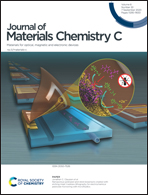Temperature evolution of (quinuclidinium)[FeCl4]: a plastic/polar magnetic hybrid compound with a giant dielectric constant†
Abstract
The temperature evolution of the physical properties of the (quinuclidinium)[FeCl4] compound shows an unprecedented series of phase, structural and magnetic transitions. Above 390 K, a plastic phase (also termed as “rotator phases”) is observed (phase I). Between 390 K and 280 K, an intermediate phase solved in a non-centrosymmetric space group has been characterized. Crystallographic studies show that the compound crystallizes in the Pbc21 polar space group (phase II), and therefore the phase transition between I and II involves a paraelectric-to-polar phase transition. This result is confirmed by complex dielectric permittivity. Moreover, the real part of the dielectric permittivity shows a giant increase above 390 K, reaching a maximum value of 105 that is notably larger than any other hybrid compound previously reported. Below 280 K, a third structural phase transition is observed, which involves the doubling of the unit cell and a change of symmetry due to the blocking of counter-ions, phase III crystallizing in the Pbca centrosymmetric space group. Below 3.5 K, long-range magnetic order is detected. Neutron diffraction below this order temperature suggests breaking of symmetry and the magnetic structure in phase IV was solved in the P21′21′21 Shubnikov space group, giving rise to a ferrimagnetic structure that allows a net ferromagnetic signal along the c-axis.
![Graphical abstract: Temperature evolution of (quinuclidinium)[FeCl4]: a plastic/polar magnetic hybrid compound with a giant dielectric constant](/en/Image/Get?imageInfo.ImageType=GA&imageInfo.ImageIdentifier.ManuscriptID=D0TC02341H&imageInfo.ImageIdentifier.Year=2020)


 Please wait while we load your content...
Please wait while we load your content...